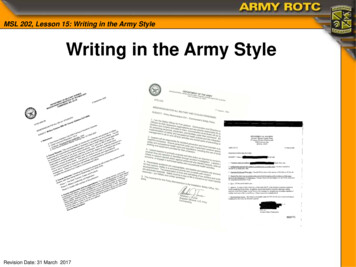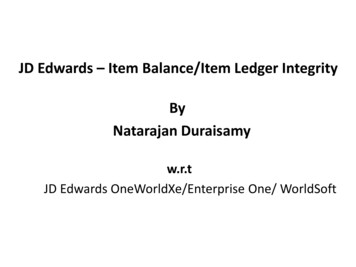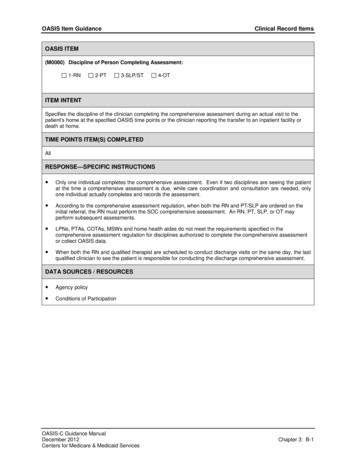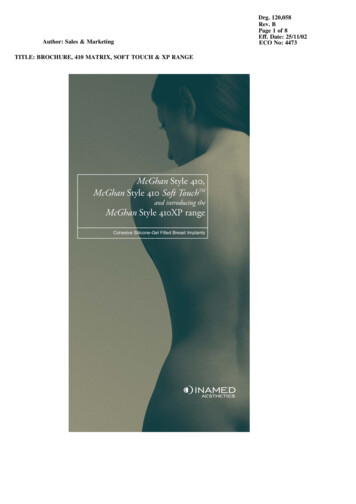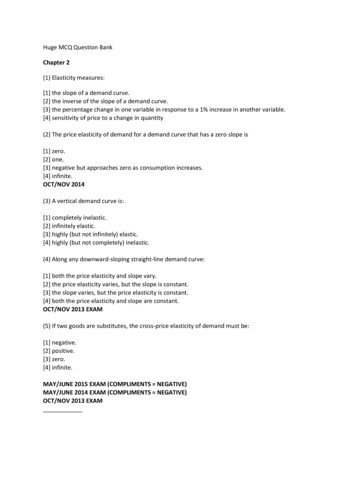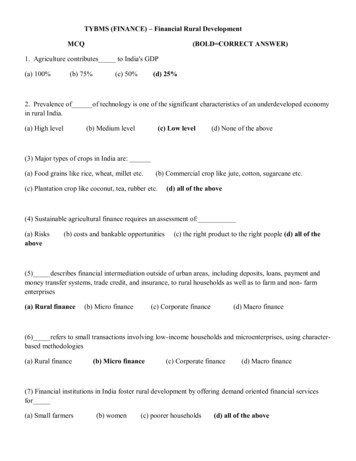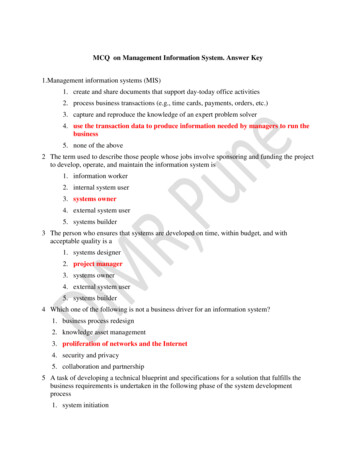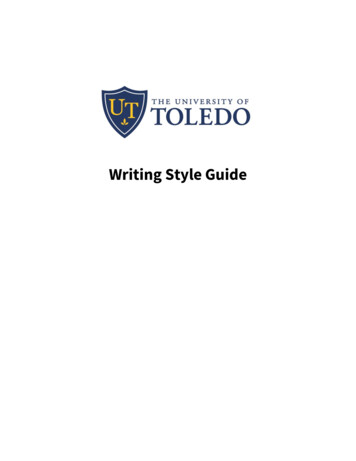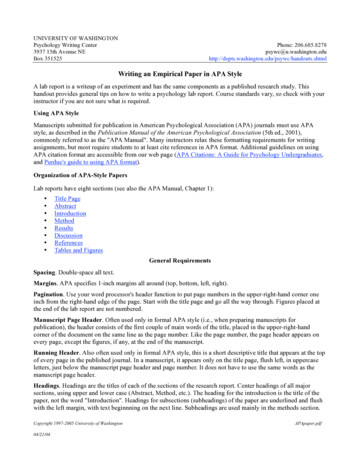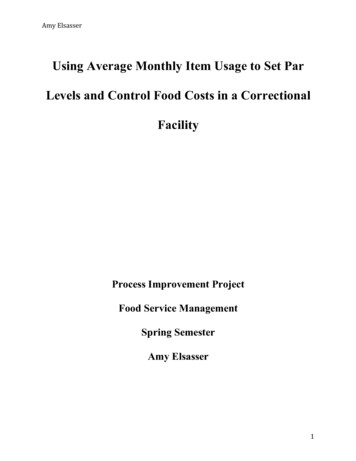
Transcription
MCQ: Item Writing and Style GuidePREFACE TO THE BOOKLET ON ITEM WRITINGThis booklet which describes the steps taken to create highquality multiple-choice questions is richly illustrated with 58examples that the text explains. There are very few sourcesthat health care professionals can use to upgrade their itemwriting skills. So this booklet should be widely welcomed.The format of the assessment items is that used in the examsdelivered by the Saudi Commission for Health Specialties. Asthe authors believe that when an item writer understandsthe theory of test measurement they will also write betteritems, some part of the booklet is given to explaining thistheory. The language used throughout is simple and easilyunderstood, reflecting one of the main goals of writing clearassessment items. The test shall be that of the construct andnot of the language used.The authors believe that the booklet shall be ascomprehensive as possible hence a series of appendicescovering Test Blueprinting, normal lab values in SI units,commonly found item writing flaws, a quick review formultiple-choice items and definitions of commonly usedpsychometric terms. The authors contributions to theCommission are highly appreciated.Professor Abdulaziz Al SaighSecretary GeneralThe Saudi Commission for Health Specialties
MCQ: Item Writing and Style GuideINTRODUCTIONMultiple-choice questions (MCQs) are the most widely used test format in the health sciencestoday. Tests using MCQs are objective, can be machine marked and easily adapted forcomputer delivery. Most educational psychologists agree that this test format can test highercognition, which is a necessity for the assessment of health care professionals. Over the lastthirty years, there has been an increasing focus on the quality of examinations for professionallicensing and certification. This in turn has led to the development of detailed guidelines,rigorous training of item writers and the application of strict criteria for quality assurance.This manual and style guide will address some of these issues and in particular focus on thedesirable standards that shall always be applied to Saudi Medical Licensing Examinations(SMLE) delivered by the Saudi Commission for Health Specialties (SCHS).The manual is expected to be updated from time to time. The development is also expected tocome from research carried out by SCHS using data from the testing activities that it isresponsible for. It is not expected that what is contained in this manual can be applied to theuniverse of testing, but is born out of best practice for the purpose that SCHS will be usingtheir testing services for. However, the text will always attempt to include a justification forthe policies and guidelines presented so that the reader can follow the logic and arrive at thesame goals that the authors of this document have.Please note that the examples given are only examples used to illustrate a point or concept,and can always be improved on. Several experienced item writers and clinicians have readthrough the manual and checked the authenticity of the content including the content of theitems used and their assistance is freely acknowledged at the bottom of this page. Finally, andimportantly, no correct key is indicated as the examples have not been independentlyreviewed or used in an SCHS exam.Mohammed Al-SultanJames WareThuraya KattanThuraya Al FawazAhmed MohammedIqbal SiddiqueWe would like to acknowledge the following doctors for their continuous support in reviewingand editing this manual:Adel Al-HadlaqAssia Al-RawafEisha GaffasMaha Al-FehailyMogbil Al HudaithyMona Al-SheikhSaleh Al-BasieSami Al-AyedFurther acknowledgment to Mr. Salem Al Tamimi for designing the cover of the manual.Page 3
MCQ: Item Writing and Style GuidePREFACEFor those who may be less familiar with multiple-choice question formats and testmeasurement, this preface shall attempt to orientate the reader. There is also a glossary1at the end of this booklet, Appendix E.A multiple-choice question consists of a stem with a question line (also known as the leadin question) at its end or underneath it. There is often a vignette or scenario embedded inthe stem. SCHS will separate a vignette in the stem from the question line by placing thequestion line in its own paragraph, see diagram below.The stem, with or without a vignette or scenarioTestNameTest result withunitsNormal values (with units)Question line in separate paragraphOptions and distractorsIn this manual there are many examples of the above, and all MCQs used for SCHSlicensing examinations shall be based on a clinical vignette. A vignette or clinical scenariomay have laboratory results, in which case the results will be put in a table beneath theclinical vignette, see above, and note that units are always provided.1Glossary has been copied from es/Glossary.htm. lastvisited on 11/17/2011.Page 4
MCQ: Item Writing and Style GuideThe number of options in an question can vary, SCHS have chosen to use four; buttheoretically up to twenty-six may be used (utilizing all the letters in the alphabet). Manyhigh stakes examination use five options because it is thought that five gives the correctimpression, while making no difference to the way the question performs. One of theoptions will be the best choice, known as the correct key, while the others are describedas distractors. An essential characteristic of all distractors, in the best one of four optionsfor example, is that all options shall present plausible answers and if possible none shall2be incorrect, as these are easily spotted as fillers and quickly discarded, making thequestion easier. All options should be on the same continuum, for example all diagnosesor all forms of management.Different types of multiple-choice questions have been designated with letters of thealphabet, which do not have any test measurement significance. The type that theCommission uses is the A-type (one best of four options). A popular type used until veryrecently in the UK was the X-type, with multiple true and false statements. This is notsuitable for assessments in the health sciences as it leads to superficial understanding,and by no means can test how a candidate will use their knowledge.Test measurements follow some important principles which need to be understood: such3as item , validity, reliability, error of measurement, distractor functionality, item writingflaw, construct irrelevant variance, discrimination index (high low), p-value (or Difficulty),biserial and point biserial, corrected biserials, test blueprint, alignment and standardsetting.Validity and ReliabilityBoth these terms refer to a whole test, while validity also applies to a single item used inan assessment. Validity implies that the item or items used test what they are supposedto test. In a simple sense an MCQ item can test knowledge, the application of knowledgeand analysis and or the synthesis of information. Clearly if an MCQ or a test paper withMCQs only seek to test recall of isolated facts, it can never test application of knowledge.Therefore, if one is claiming to test application of knowledge and uses such recall typequestions this test is not a valid test of what is being tested for.In order for an assessment to be truly valid it must be reliable or reproducible. In otherwords every item needs to be testing the same characteristic or trait. When every itemtests the same trait and we have enough items, we take the candidate’s scores orperformance for the first half of all items and correlate these with the second half ofitems, a correlation coefficient is derived. Usually 0.85 is considered satisfactory for aninstitutional exam, while a national licensing examination shall have a reliability of 0.90.23A filler is an option that is inadequate and seemingly has no place in the question.Item is a single test element, which might be a multiple-choice question.Page 5
MCQ: Item Writing and Style GuideReliability is calculated by a formula (e.g., Kuder-Richardson) or correlations derived usingcomparisons of halves (as above, or odd numbered items versus even).Validity is determined by human judgment. And, validity is not necessary for reliability. Itcan be noted that for an examination to be reliable there shall be at least 100 items inthe test. If on the other hand fewer items are used a formula (Spearman-Brown) willindicate for a given reliability how many items are needed to meet the required level.Error of MeasurementAll tests have measurement error. The more discriminating a test is, the greater is themeasurement error, and so on one hand a desirable outcome is obtained and on theother the actual score given to a candidate becomes less secure. The error measurementbecomes greater in proportion to changes in the standard deviation about the mean ofall candidate scores.Distractor FunctionalityThe point of using distractors is that the weak student will believe that they representplausible answers to the question asked. However, if less than 5% of all candidates selecta distractor, that distractor is said to be non-functional. The functional distractorfrequency (FDF) even with five or six distractors is approximately 1.8-2.0 distractor peritem. Clearly if the items are too easy or difficult (average correct responses above 90%or below 20%) then the number of functioning distractors is relatively less, the moredesirable being when average test scores for the class are between 45% and 55%, see Fig1. The item FDF is an indication of quality for an item, provided other data areconsidered. However, scores below forty percent cannot be said to demonstrate asufficient amount of knowledge or its application to satisfy a professional examination.Figure 1Page 6
MCQ: Item Writing and Style GuideFigure 1. The mean test scores from a series of examination were used (n 35) andcorrelated with the mean FDF for each. Note, above 90% the FDF is zero and similarlybelow a MTS 40% all four distractors (A-type, one best of best options) are functional;Ware and Mohammed, 2010.Item Writing Flaws (IWFs) and Construct Irrelevant VarianceThere are some generally accepted guidelines about item writing but only recently inhealth sciences was it possible to demonstrate that the presence of item writing flawscan lead to incorrect exam results. Many believe that writing negatively phrasedquestions is acceptable because the item tests a wider range of knowledge. The widerrange is only tested at the level of recall or memorized fact, while tests in health sciencesneed application, analysis and synthesis. Tarrant and Ware have demonstrated that usingexaminations with a substantial number of flawed items leads to passing a significantnumber of borderline candidates who should not have passed and denying an evengreater number of distinction candidates their true rewards (Medical Education 2009).With proper preparation and training, the frequency of IWFs shall be 7% in anyassessment (Ware and Vik, 2009). It is extremely important that any reviewer is familiarwith recognizing IWFs and aware how best to edit them out without changing the focusor meaning of an item.Borderline candidates often depend on using IWFs and test wiseness to gain extra markswithout having done the work necessary in the course studied. Therefore, for thesecandidates the assessment not only tests their learnt knowledge but also their test takingability and use of test wiseness, two attributes which distort the score awarded. This falsemeasurement is called construct (the intended focus of the test) irrelevant variance.Another example might be when jargon or poor language causes the candidate to beconfused, giving rise to the often complained of problem with MCQs, when the candidatedoes not know exactly what the question is being asked for.High-Low Discrimination Index (DI)A good MCQ item shall discriminate between a top student and weak student. The topstudent will be able to score more correct items than the weak student. So, if one takesthe proportion of the top students who get a given item correct and those from thebottom students and then determines the numerical difference, figures between 1through zero to -1 are obtained for every item. Note that if the MTSs for the assessmentsare either high or low (cf., FDFs) the discrimination indices will be near to zero or evennegative. A good DI is 0.4 and anything below 0.10 should be revised, while DIs at zeroor negative are unacceptable and the item should usually be revised. DIs are usefulmarkers for quality (Ware and Vik, 2009).Page 7
MCQ: Item Writing and Style GuideDifficulty, (facility) or p-valueAll three refer to the proportion of candidates that marked the correct key for a givenitem. Ideally a test shall have an MTS of 50% - 70%, as this will give the highest mean DIand reliability.Biserials (including point and corrected)Point biserial coefficients (RPBS, apply only to MCQs), biserials (RBS) and corrected RPBSand RBS are correlations between candidate performance on any item and their overallperformance on the whole test. Just as negative high-low discrimination is an indicator ofa poor quality or flawed item, a negative biserial is an even stronger indicator of thesame. Usually such questions are removed before calculating the final score for eachcandidate. A corrected biserial is the same index but the item in question has beenremoved before calculating the final result for comparison with the actual item.Test Blueprint (TB) and AlignmentFor any assessment to represent a valid test of whatever it is that is being tested for, thecontent of the examination shall be strictly controlled. This is partially achieved by writingdown exactly what shall be tested and having a panel of experts agree on this. Usuallythe TB is drawn up as matrix, because many skills are common to a large part of content,for example making a diagnosis. Usually the
quality multiple-choice questions is richly illustrated with 58 examples that the text explains. There are very few sources that health care professionals can use to upgrade their item writing skills. So this booklet should be widely welcomed. The format of the assessment items is that used in the exams
